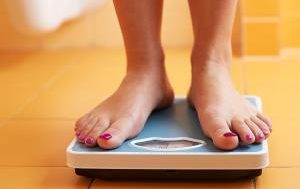You’ve probably heard that you can’t out-exercise a bad diet, so what you put into your body matters, especially if you’re looking to lose weight safely. “Food is everything, and exercise is extra credit,” says Ilana Muhlstein, MS, RDN, who is part of the executive leadership team for the American Heart Association. “The bottom line is everyone needs to get the food part in order to figure out what’s working from a food-based perspective on how to lose weight.”
Muhlstein maintains that once you’ve focused on making healthy eating changes, then you can start to incorporate exercise, which will make you feel good and help you boost your metabolism.
That’s not to say exercise has to come secondary to food. Katie Hake, RDN, ACSM-CPT, finds that fitness is more than just about burning calories; it can also help change your perspective on the type of food you want to consume so your body is being properly nourished.
“I find that a lot of clients tend to have more success when they exercise, not necessarily because they’re burning more calories, but because it creates that mindset shift of Look at what my body can do physically in the gym; how is that going to help me mentally with different decisions that I make and the foods that I eat,” says Hake.
Debbie S. Fetter, PhD, an assistant professor of teaching nutrition at UC Davis, agrees that “ultimately both your eating pattern and activity level both influence and work together to help with sustainable weight loss.”
Read on for safe and sustainable weight-loss tips from the experts.
Knock Knock #Goals Pad ($8)
Fetter suggests being specific when setting your goals. Rather than writing that you want to lose weight, she says to break it down: Think about how much weight you want to lose, over what amount of time, and how you plan to accomplish your goal. “Setting a specific goal will make it more into reality,” says Fetter, who suggests thinking about the acronym S.M.A.R.T. goals, which stands for specific, measurable, actionable, relevant, and time-bound. “When it becomes more like a habit and pattern, you don’t have to be as stringent.”

View photos
If you know you’re the type to finish an entire bag of chips while watching Netflix on the couch (guilty!), maybe next time portion out the chips into a bowl, so you’re aware of how much you’re consuming and when you’re done eating. “Find behaviors that you can change,” says Fetter.
Hake also believes in paying attention to habits instead of only focusing on what you’re eating, stating, “Check in with yourself before and after a meal to see if you’re eating the amount or type of foods that help you feel your best. That can help identify whether you’re eating based on social circumstances or emotions or stress.”
4. Drink More Water

View photos
Hydro Flask Water Bottle ($30)
Before every meal, Muhlstein recommends drinking water first, about 16 ounces if possible. “Everyone always thinks they’re hungry and more often we’re thirsty and don’t realize it,” Muhlstein expresses. Drinking water “creates a greater sense of fullness and works to help minimize your appetite.” Don’t forget to stay hydrated before, during and after a workout, too. Muhlstein urges people to increase their water needs while exercising and to think about “half the minutes in ounces,” so a 60-minute workout should include a 30-ounce of water.

View photos
Instead of looking toward healthy foods you think you have to eat, consider nutritious options you’d actually want to eat. “Too often people try to force themselves to eat what they consider to be healthy food all the time, and they really don’t like it,” says Fetter. Think about the vegetables, fruits, and whole grains that you can prepare in different ways that you’d enjoy. If you’re tired of eating steamed broccoli, change it up and opt for roasted broccoli with a bit of olive oil and seasoning, for example.

View photos
When it comes to consuming fruit juices, Muhlstein declares, “It’s like drinking sugar.” Instead, it’s more beneficial to eat whole fruits, so you can benefit from “the chewing sensation that helps contribute to fullness and the fiber that is actually filling up your stomach.”

View photos
“A lot of people want to focus on what they want to take out, but the best, most effective way to change your food, help you lose weight, and feel full and satisfied along the way, is to add more vegetables to your meal,” Muhlstein emphasizes. Adds Fetter: “The fiber and water that come from veggies help fill you up.” So the next time you plan to make an omelet, feel free to throw in extra mushrooms, peppers, and chopped onions.

View photos
Similar to veggies, it’s important to include lean sources of protein (some recommendations here) with every meal. Research has shown that “high protein meals lead to a reduced subsequent energy intake.” Other benefits of protein include increasing your metabolism, improving your mood, and keeping your hair and nails healthy.

View photos
Healthy fats help “increase fullness because fat slows digestion down and adds flavor,” explains Fetter, who notes that there are two essential fatty acids—linoleic acid and linolenic acid—that we need to get from our diet. Linoleic acid (omega-6 fatty acid) is found in vegetable oils, nuts and seeds, while linolenic acid (omega-3 fatty acid) appears in fatty fish, including salmon and tuna, flaxseeds and walnuts. Fetter also points out, “When it comes to fat, it is used for many essential functions in the body. It’s not just insulation for organs and being a source of calories for energy; it helps with hormonal responses.”
However, Muhlstein cautions people to be more mindful when consuming healthy, high-fat foods. “People are eating whole avocados at a time, but the recommendation for fat intake is about 20 to 30 percent of our daily caloric intake,” she says. “I think people need to be more moderate with healthy fat. We live in a culture of extremes, so people hear fat and they run so far with it that they are literally just eating coconut oil and adding it to their coffee. That’s not necessary and not necessarily going to help you lose weight.”

View photos
You’ve probably heard about how keto, Paleo, and gluten-free diets have helped people lose weight. But before you consider taking those approaches, Hake explains, “For most people, if you don’t have some sort of genetic disorder or you’re overall fairly healthy, there’s no need to cut out any food group. Study shows that when we restrict or cut out a certain food group, that if we do that long enough, history repeats itself. Eventually we swing the other way, and we end up wanting to eat all the carbs in our pantry.” It’s always best to work with a registered dietitian when thinking about these diets because every person’s nutritional needs may vary.

View photos
Hopping on the treadmill doesn’t have to be your only option when it comes to exercise (unless that’s your preference, then please go forth). There are plenty of physical activities to choose from, whether it’s a HIIT workout, dance class, or yoga session. Once you find an exercise you enjoy, Fetter encourages people to look at their weekly schedules and pencil in those workouts where there’s free time in their calendars. According to the American Heart Association, the current physical activity recommendations for adults are 150 minutes of moderate to vigorous movement per week.

View photos
Research has shown that lack of sleep can lead to weight gain, so it’s critical to catch some z’s if you’re looking to slim down. A study led by Erin Hanlon, PhD, and Eve Van Cauter, PhD, at the University of Chicago observed that when sleep-deprived, “Your hedonic drive for certain foods gets stronger, and your ability to resist them may be impaired. So you are more likely to eat it. Do that again and again, and you pack on the pounds.”
In addition to weight loss, sleep can help improve cognition and boost your immunity, adds Muhlstein, who urges sleeping at least seven hours a night.

View photos
“The amount of weight loss for sustainable weight loss is about losing one to two pounds a week, so nothing drastic,” expresses Fetter, who notes that when it comes to living a healthy lifestyle, “It truly is about making lifelong changes to both your eating and activity patterns, and being able to do that in a sustainable way so that it’s an enjoyable life experience.”
Next up: The 12 Most Effective Fat-Burning Foods, According to Science
This article originally appeared on The Thirty
Read More from Who What Wear


